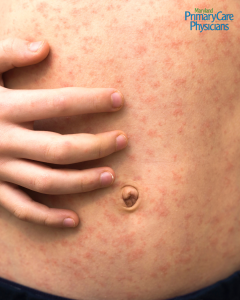Category Archives: Health & Wellness

Protecting Our Community from Measles: It Starts Here
At Maryland Primary Care Physicians, we believe that caring for our patients means caring for the communities they belong to. When one person stays healthy, we all benefit, and when someone is at risk, it’s our responsibility to help protect them.
The Maryland Department of Health has confirmed multiple cases of measles in Maryland. While this may feel like a distant concern to some, we see it differently. As physicians, we understand how quickly this illness can spread, and as members of the community, we know how deeply prevention matters.
This is about more than avoiding an illness, it’s about protecting the people around us. And as we observe National Public Health Week, we want to remind you that public health starts right here. With you. With us. Together.
Why Measles Deserves Our Attention
According to the Centers for Disease Control and Prevention, if one person has measles, up to 90% of unvaccinated people who come into close contact will also become infected. The virus spreads through the air and can linger in a room for up to two hours after an infected person has left.
 Symptoms usually begin 7 to 14 days after exposure. Early signs include:
Symptoms usually begin 7 to 14 days after exposure. Early signs include:
- High fever (often over 104°F)
- Cough
- Runny nose
- Red, watery eyes
A few days later, a red rash starts on the face and spreads downward across the body.
While most people recover, measles can lead to serious health complications. These include pneumonia, brain swelling, and in some cases, death—especially in young children and those with weakened immune systems. As Johns Hopkins Medicine explains, measles can still be dangerous even with modern medical care. The virus is not gone. It’s just kept in check through vaccination.
Vaccination Is the Best Protection
The MMR vaccine is the most effective way to prevent measles. It is safe, widely available, and incredibly effective.
According to the University of Chicago Medicine, two doses of the MMR vaccine are about 97% effective at preventing measles. The vaccine also protects against mumps and rubella.
Here’s what we recommend:
- Children should receive their first vaccination between 12 and 15 months of age
- A second dose is given between 4 and 6 years old
- Adults who missed one or both doses or who are unsure of their status should speak with a provider
- International travelers and healthcare workers may require additional protection
Vaccination is not just a personal decision. It is a public service. It protects newborns who are too young for vaccines. It shields those going through chemotherapy or living with chronic illness. It helps build a stronger, healthier community for everyone.
Why This Matters to MPCP
Maryland Primary Care Physicians is a doctor-led organization with strong roots in the communities we serve. We are not just here to treat illness. We are here to build relationships, provide trusted information, and help you make decisions that support your health and the well-being of others.
Many of our physicians live in the same communities where they practice. That connection drives our mission. It also informs our approach. We know that public health starts at the local level—in schools, churches, workplaces, and yes, right here in your doctor’s office.
As we recognize National Public Health Week, we want to underscore what this year’s theme—It Starts Here—really means. It means:
- It starts in conversations between you and your provider
- It starts with the decisions you make for your family
- It starts with our shared commitment to care
Let’s Take Action Together
If you need to check your vaccine records or schedule a catch-up dose, we are here for you. Talk to your provider. Book a visit. Encourage your friends and family to do the same.
It all adds up. It all matters.
It starts here.

Know Your Gut: Colorectal Cancer Awareness and Early Detection
Colorectal cancer is one of the most common cancers in the U.S., yet it’s also one of the most preventable. With early detection and lifestyle changes, you can dramatically lower your risk. Colorectal cancer is often diagnosed at advanced stages when treatment options are limited, so, the most important step you can take is to stay on top of your screenings and reduce your risk factors.
Here’s what you need to know to protect your gut health and take charge of your future.
What Is Colorectal Cancer and Who’s at Risk?
Colorectal cancer begins in the colon or rectum and often starts as small growths called polyps. Over time, some of those polyps can turn into cancer.
Who should start screening?
- Everyone should begin regular colorectal cancer screenings at age 45.
- Individuals with a family or personal history of colorectal cancer, genetic conditions (like Lynch syndrome), or inflammatory bowel disease may need to start screening earlier.
What are the most common risk factors?
- Age: Most cases occur in adults over 45.
- Family history: A family history of colorectal cancer or polyps can increase your risk.
- Personal history: Women with uterine polyps can have a higher risk for colorectal polyps.
- Genetic conditions: Conditions like Lynch syndrome or familial adenomatous polyposis (FAP) raise the risk significantly.
- Inflammatory bowel disease: Crohn’s disease or ulcerative colitis increases the likelihood of developing colorectal cancer.
- Type 2 diabetes: People with type 2 diabetes face a higher risk, even after accounting for shared factors like weight or inactivity.
If any of these apply to you, talk to your provider about starting screenings earlier or more frequently.
Change What You Can: Lifestyle Risk Factors
More than half of colorectal cancer cases are linked to lifestyle factors that you can control. By making healthy changes, you can lower your risk factors for colorectal cancer:
- Achieve and maintain a healthy weight: Being overweight or obese increases your risk, especially for men. Losing even a small amount of weight can help.
- Eat a healthier diet: Limit red and processed meats, such as hot dogs and bacon, and focus on a diet rich in fruits, vegetables, and whole grains. Cutting back on sugary drinks can also make a difference.
- Stay active: Regular physical activity can significantly reduce your risk of colorectal cancer and improve overall health.
- Quit smoking: Smoking isn’t just linked to lung cancer; it’s also a major risk factor for colorectal cancer. Quitting now can lower your risk over time.
- Limit alcohol intake: Heavy drinking is associated with higher colorectal cancer risk. It’s best to avoid alcohol, but if you drink, limit yourself to no more than one drink per day for women or two for men.
Talk to Your Provider About Your Risk Factors
Are you over 45? Do you know your personal risk factors? The best time to take action is now. Talk to your MPCP provider to discuss when you should start screenings and how you can live healthier and lower your colorectal cancer risk.

Cervical Cancer Awareness: Why Early Detection and Advocacy Save Lives
Cervical cancer was once one of the most common and deadly cancers for American women. Thanks to advances in prevention and screening, cervical cancer incidence and mortality rates have dropped significantly since the 1970s.
However, recent trends reveal a complex picture: rates are increasing in some age groups, and disparities persist. This Cervical Cancer Awareness Month, we encourage you to advocate for your health by staying informed, getting screened, and taking preventive action.
Cervical Cancer Trends: Progress and Challenges
- Incidence Rates: Cervical cancer cases have dropped by more than half since the 1970s, largely due to widespread Pap testing. However, rates have stabilized in recent years, and for women ages 30–44, rates increased by 1.7% annually from 2012 to 2019.
- HPV Vaccination Impact: Among women aged 20–24, rates have declined by 11% each year, showing the early effects of HPV vaccination.
- Mortality Rates: Death rates have dropped by more than half since the 1970s, but disparities remain. Black and Native American women have cervical cancer death rates 65% higher than White women, underscoring the need for equitable access to care.
These numbers show that prevention works, but continued vigilance and action are essential.
Why Early Detection Matters
Cervical cancer is highly treatable when caught early, often before symptoms develop. Pap tests detect precancerous changes, allowing providers to address them before they progress. For many women, the HPV vaccine adds an extra layer of protection, preventing the infections responsible for most cervical cancers.
Advocating for Your Health: What Every Generation Needs to Know
Prevention and early detection start with awareness and self-advocacy. Here’s what you should consider based on your age and risk factors:
- Teens and Young Adults (Ages 9–26): Focus on Prevention
The HPV vaccine is most effective when given early, starting at age 9. If you or your children haven’t been vaccinated, it’s not too late. Talk to your doctor about the benefits of the vaccine for cancer prevention. - Women in Their 20s: Establish a Routine
Start regular Pap tests at age 21. These screenings are critical for detecting abnormal cells early. Consider discussing co-testing with HPV tests, which provides a more complete picture of your risk. - Women Ages 30 to 44: Practice Increased Vigilance
Cervical cancer rates are rising in this group, making consistent screening more important than ever. Ask your provider about personalized screening schedules based on your medical history. - Post-Menopausal Women: Keep the Conversation Going
Some women assume they can stop screening after menopause, but that’s not always the case. Talk to your provider about whether continued screenings are necessary based on your health history.
Addressing Health Disparities: Advocating for Equity
It’s vital to address the disparities that put some women at greater risk. Black and Native American women, in particular, face higher mortality rates. If you or a loved one has experienced barriers to screening or care, advocate for your needs. Speak openly with your provider, and don’t hesitate to seek support to ensure you receive this vital care.
Prevention Starts with You
- Are you up to date on your Pap tests and HPV screenings?
- Have you or your children received the HPV vaccine?
- Do you know your family history and personal risk factors?
At Maryland Primary Care Physicians, we’re here to support you every step of the way. Reach out to your provider to discuss your risk factors and next steps—whether it’s scheduling a Pap test, getting the HPV vaccine, or reviewing your screening schedule.

Understanding Osteoporosis: How to Keep Your Bones Strong for Life
We often focus on our hearts, weight, or blood pressure when we think about health. But how often do you think about your bones? Strong bones are just as essential to overall health as our weight or activity levels. In fact, bone health is so critical that osteoporosis—often called a “silent disease”—can lead to serious health risks, including fractures that may impact quality of life and even shorten it.
Here’s what you need to know about osteoporosis, why it’s so important to protect your bones early in life, and how to take action if you think you’re at risk.
What Is Osteoporosis, and Why Does It Matter?
Osteoporosis is a condition where bones lose density and strength, becoming more brittle over time. While most common in adults over 50, this deterioration can start much earlier in life due to poor habits or underlying health issues.
Fractures caused by osteoporosis aren’t just inconvenient—they’re serious. Studies show that a broken hip or spine can lead to reduced mobility, a higher risk of other health issues, and even increased mortality, similar to heart attacks or breast cancer. That’s why caring for your bones is just as important as caring for your heart.
Prevention Starts Early: Build Strong Bones Now
Building strong bones starts in childhood and continues into your 20s and 30s when bone density peaks. But it’s never too late to make changes that strengthen your bones and improve your overall health.
Here are a few key habits to adopt:
- Eat for Bone Health: Include calcium-rich foods like dairy, leafy greens, and fortified cereals in your diet. Don’t forget about vitamin D, which helps your body absorb calcium.
- Get Moving: Weight-bearing exercises like walking, jogging, and resistance training can help build and maintain bone density.
- Ditch the Bad Habits: Smoking and excessive alcohol weaken bones over time. Quitting can make a big difference in your bone health.
Research has also shown that healthy habits benefiting your heart—like those outlined in the American Heart Association’s “Life’s Essential 8”—can also protect your bones. That’s because lifestyle factors like eating well and staying active reduce inflammation and promote overall health.
Are You at Risk? Spotting the Signs of Weak Bones
Osteoporosis is often called a “silent disease” because you can’t see or feel your bones weakening. That’s why it’s so important to pay attention to early warning signs:
- Fractures from minor falls or bumps
- A noticeable loss of height over time
- Persistent back pain, which could indicate a spinal fracture
If any of these sound familiar, or if you have a family history of osteoporosis, talk to your doctor. Early detection through a bone density test can help catch the condition before a serious fracture occurs.
Watch: Early detection can make a big difference.
What If You Already Have Osteoporosis?
If you’ve been diagnosed with osteoporosis, know that you’re not alone—and there are effective treatments available. Your doctor may recommend:
- Medications to slow bone loss or build new bone
- A personalized exercise and diet plan
- Strategies to reduce fall risks and protect your bones
Sticking to your treatment plan is essential. Studies show that many people stop taking their medications or don’t follow through with their exercise or diet plans.
Take Control of Your Bone Health Today
Your bones are the foundation of your body—literally. Taking care of them is an investment in your future mobility and independence.
Here’s how you can get started:
- Schedule a checkup with your primary care provider to discuss your risk factors.
- Adopt bone-healthy habits like exercise and a balanced diet.
- Stay informed!



